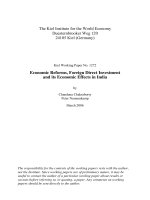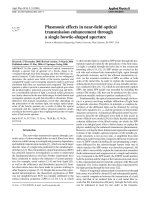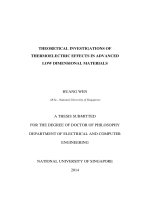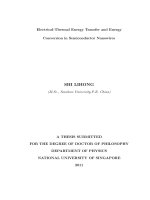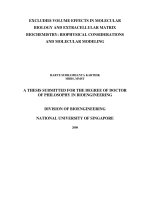Electrical conductivity switching behavior and memory effects in electroactive polymers and nanocomposites
Bạn đang xem bản rút gọn của tài liệu. Xem và tải ngay bản đầy đủ của tài liệu tại đây (4.44 MB, 206 trang )
i
ELECTRICAL CONDUCTIVITY SWITCHING BEHAVIOR
AND MEMORY EFFECTS IN ELECTROACTIVE
POLYMERS AND NANOCOMPOSITES
LIU GANG
(M. Sci., Singapore-MIT Alliance, NUS)
A THESIS SUBMITTED FOR
THE DEGREE OF DOCTOR OF PHILOSOPHY
DEPARTMENT OF CHEMICAL AND BIOMOLECULAR ENGINEERING
NATIONAL UNIVERSITY OF SINGAPORE
SINGAPORE, JULY 2010
ii
ACKNOWLEDGEMENT
First and foremost, I would like to express my sincerest and deepest appreciation to
my supervisors, Professor Kang En-Tang and Professor Neoh Koon-Gee, at National
University of Singapore, for their invaluable guidance, suggestion, and discussion
throughout this work. I was especially fortunate to be able to work under the
supervision of Professor Kang En-Tang, who leads me into the great world of polymer
electronics. Professor Kang and Professor Neoh’s abundant knowledge in polymer
related areas is always a source of inspiration to me in carrying out this project.
Whenever I came across a problem, I knew for sure that I could turn myself to my
supervisors, Professor Kang and Professor Neoh, for their sincere and unreserved
suggestion and help. Their enthusiasm, diligence, patience, and preciseness enlighten
me on the road of scientific research, and even my future road of life, no matter in
academic or industrial area, regardless of the country in which I stay.
I have benefited greatly from the collaboration with Professor Liaw Der-Jang and Dr.
Chang Feng-Chyuan, from National Taiwan University of Science and Technology,
and Dr. Chen Yu and Mr. Zhuang Xiaodong, from East China University of Science
and Technology. I acknowledge with gratitude for the materials used in this project,
provided by Professor Liaw, Dr. Chen, and their research staffs and students.
I am also indebted to Dr. Zhu Chuxiang, Dr. Ling Qidan, Dr. Tong Shy Wun, Dr. Lim
Siew Lay, Dr. Zhang Zhiguo, Mr. Eric Teo Yeow Hwee, Mr. Liu Yiliang, Mr. Zhang
Chunfu, and Ms. Wan Dong, for their fruitful discussion and comments during this
iii
work. I would like to express my particular gratitude to Dr. Ling Qidan, from whose
generous consultation and invaluable experience I learnt heavily for my own work.
In addition, I wish to thank the laboratory technologists, Ms. Novel Chew Su Mei, Ms.
Alyssa Tay Kai Si, Ms. Xu Yanfang, and Mr. Ng Kim Poi, for their time and
assistance during this work.
Fully as important as the scientific guidance of my supervisors and the help of my
colleagues have been the love and encouragement of my devoted parents, Mr. Liu
Zhiran and Ms. Zhang Guiying, and my devoted wife, Ms. Zhou Jinjia. The
unconditional love and sacrifice of my family during this four-year project made me
fully concentrate on my research work without concerning too much about the daily
issues. Their consistent care and support enable me healthy enough, both mentally and
physically, to finish this work. Nevertheless, my uncles, Professor Wang Erlin and
Professor Gu Yaoxin, helped me to clarify my aspiration when I was hesitating and
wandering in doubt. The continuous love, support, and encouragement of my family
are always the power of advancing in my profession.
Last but not least, I appreciate the financial support provided by the National
University of Singapore in the form of research scholarship to carry out this work.
iv
TABLE OF CONTENTS
ACKNOWLEDGEMENT ii
TABLE OF CONTENTS iv
SUMMARY vii
NOMENCLATURE xi
LIST OF FIGURES xiv
LIST OF TABLES xx
CHAPTER 1 INTRODUCTION 1
CHAPTER 2 LITERATURE SURVEY 5
2.1 Current Status of Electronic Memories 6
2.2 Basic Concepts of Electronic Memories 10
2.3 Brief History of Polymer Electronic Memories 14
2.4 Classification of Polymer Electronic Memories 19
2.4.1 Transistor-type polymer memories 19
2.4.2 Capacitor-type polymer memories 23
2.4.3 Resistor-type polymer memories 25
2.5 Conduction Mechanisms of Polymer Memories 28
2.5.1 Filament conduction 28
2.5.2 Space charges and traps 31
2.5.3 Charge transfer effects 32
2.5.4 Tunneling effects 33
2.5.5 Conformational change effects 35
CHAPTER 3 FLUORENE POLYMERS 36
3.1 Introduction 37
3.2 Experimental Section 39
3.3 Results and Discussion 48
3.3.1 Bistable conductivity switching and WORM memory effects of PFPTPA 48
3.3.2 Tristable conductivity switching and WORM memory effects of PFPCz 55
3.3.3 Electrical properties of PFPPy 67
v
3.4 Conclusion 71
CHAPTER 4 IMIDE POLYMERS 72
4.1 Introduction 73
4.2 Experimental Section 75
4.3 Results and Discussion 80
4.3.1 Bistable conductivity switching and WORM memory effects of PCz6FDA 80
4.3.2 Electrical properties of PNa6FDA 91
4.4 Conclusion 93
CHAPTER 5 (POLY(VINYLCARBZOLE-AZOBENZENE-ACCEPTOR) COMPL
EX 94
5.1 Introduction 95
5.2 Experimental Section 98
5.3 Results and Discussion 100
5.3.1 Bistable conductivity switching and WORM memory effects of
PVK-AZO-NO
2
100
5.3.2 Bistable conductivity switching and WORM memory effects of
PVK-AZO-2CN 109
5.4 Conclusion 111
CHAPTER 6 POLYMER-CARBON NANOTUBE COMPOSITES 112
6.1 Introduction 113
6.2 Experimental Section 115
6.3 Results and Discussion 118
6.3.1 Enhancement of the PFPTPA memory device performance via CNT doping 118
6.3.2 Tuning of the electrical properties and controlling of the conductivity
switching behavior and memory effects of PVK-CNT composites 124
6.4 Conclusion 137
CHAPTER 7 POLY(N-VINYLCARBAZOLE)-GRAPHENE OXIDE COMPLEX 138
7.1 Introduction 139
7.2 Experimental Section 141
7.3 Results and Discussion 143
7.3.1 Material characterization 143
vi
7.3.2 Bistable conductivity switching and rewritable memory effects of GO-PVK 150
7.4 Conclusion 156
CHAPTER 8 CONCLUSION 157
CHAPTER 9 RECOMMENDATIONS FOR FUTURE WORK 162
REFERENCES 166
LIST OF PUBLICATIONS 185
vii
SUMMARY
Organic and polymeric materials can exhibit electric-field-induced electrical
conductivity switching behavior and resistor-type electronic memory effects. The
field-induced electrical bistability, together with the low-cost potential, light weight,
mechanical flexibility, and the most important of all, tunable electronic properties via
molecular design, make organic and polymer materials promising alternatives or
supplements to inorganic semiconductors in data storage technologies. In this work, a
series of polymers and polymer composite materials were explored for electronic
memory applications. The focus of this work is concentrated on studying the electrical
properties and the underlying switching and conduction mechanisms of the
electroactive polymers and nanocomposites.
Conjugated fluorene copolymers of poly(2,6-diphenyl-4-((9-ethyl)-9H-carbazole)-py-
ridinyl-alt-2,7-(9,9-didodecyl)-9H-fluorenyl) (PFPCz), poly(2,6-diphenyl-4-tripheny-
lamine-pyridinyl-alt-2,7-(9,9-didodecyl)-9H-fluorenyl) (PFPTPA), and poly(2,6-diph-
enyl-4-pyrene-pyridinyl-alt-2,7-(9,9-didodecyl)-9H-fluorenyl) (PFPPy) (structures
shown in Figure 3.3, 3.4 and 3.5, respectively) were first synthesized via Suzuki
coupling polymerization reaction. The electrical behavior of these polymers was
found to be dependant on the molecular structure of the macromolecules. Both
write-once read-many-times (WORM) memory effects (PFPCz and PFPTPA) and
insulator (PFPPy) behavior are demonstrated in the current density-voltage (J-V)
characteristics of the devices with aluminium (Al)/polymer/indium-tin oxide (ITO)
viii
sandwich structure. The electrical conductivity switching behavior of these fluorene
polymers is ascribed to electric field-induced conformational ordering and/or charge
transfer (CT) interaction of the polymer film in the devices.
To achieve a higher ON/OFF state current ratio and thus a lower misreading rate of
the polymer electronic memories, two non-conjugated imide polymers,
poly(2,6-diphenyl-4-((9-ethyl)-9H-carbazole)-pyridinyl-alt-hexafluoroisopropylidene
diphthal-imide) or PCz6FDA, and poly(2,6-diphenyl-4-napathalene)-pyridinyl-alt-he-
xafluoroisopropylidenediphthal-imide) or PNa6FDA (structures shown in Figure 4.2
and 4.3, respectively), were synthesized via a two-step polymerization reaction,
involving a ring-opening poly-addition reaction and the subsequent chemical
imidization reaction. The incorporation of a stronger electron withdrawing group (as
compared to the pyridine electron acceptor), hexafluoroisopropylidenediphthalimide
(or 6FDA), can significantly enhance the field-induced CT characteristics of the imide
polymers. The Al/PCz6FDA/ITO device exhibits electrical bistability and WORM
memory effects with an ON/OFF state current ratio of 10
5
, while the PNa6FDA
device behaves as an electrical insulator. The electrical bistability of PCz6FDA device
is well maintained at elevated temperatures and thermally stable electronic memory
device is thus demonstrated. The bistable switching behavior of PCz6FDA is
attributed to intra-molecular CT interaction under an electric field, while the lack of
electrical bistability in PFPPy and PNa6FDA are ascribed to the absence of effective
electron donating species in the pendant groups.
ix
Capitalizing on the charge trapping ability of azobenzene chromophores, electrical
bistability with enhanced ON/OFF state current ratios in excess of ~ 10
5
were
demonstrated in two donor-trap-acceptor (D-T-A) structure carbazole-azobenzene
polymers. Synthesized via a post azo-coupling reaction, poly(3-(4-nitrophenyl)-diaze-
nyl-9-vinylcarbazole-alt-9-vinylcarbazole) (PVK-AZO-NO
2
), and poly(3-(3,4-dicya-
nophenyl)-diazenyl-9-vinylcarbazole-alt-9-vinylcarbazole) (PVK-AZO-2CN)
(structures shown in Figure 5.3) possess pendant electron D-A pair
(carbazole-nitro/cyano) and charge trapping center (azobenzene) at the same time,
allowing effective stabilizing of the intra-molecular CT state, and leading to WORM
memory effects with low switching voltages and high ON/OFF state current ratios.
In addition to molecular design and organic chemistry, the electronic properties of
polymers can also be controlled by forming composites with other electroactive
materials. The bistable switching behavior and memory effect of the fluorene polymer
PFPTPA can be enhanced upon mixing the polymer with carbon nanotubes (CNTs)
Furthermore, by varying the carbon nanotube content in poly(N-vinylcarbazole) (PVK)
composite films, the electrical conductivity of the PVK-CNT doping system can be
tuned deliberately. The Al/PVK-CNT/ITO sandwich structure exhibits insulator,
bistable electrical conductivity switching (WORM memory and flash memory effects),
and conductor behaviors, when the CNT content in the composite film is increased
from 0 to 3%. The conductivity switching effects of the PVK-CNT composite films
are ascribed to electron trapping in the CNTs of the hole-transporting PVK matrix.
x
Similar to its consanguinity of C
60
and carbon nanotube, the large numbers of
hexagonal aryl make graphene material a good electron acceptor. The atomic
nanosheets of graphene enhance its potential application in ultrathin electronic
devices. A solution-processable and electroactive complex of
poly(N-vinylcarbazole)-derivatized graphene oxide (GO-PVK) was prepared via
amidation of end-functionalized PVK, from reversible addition fragmentation chain
transfer (RAFT) polymerization, with tolylene-2,5-diisocyanate-functionalized
graphene oxide (GO-TDI). The Al/GO-PVK/ITO device exhibits bistable electrical
conductivity switching and non-volatile rewritable memory effects. Both the OFF and
ON states of the memory device are stable under a constant voltage stress of -1 V for
up to 3 h, or under a pulse voltage stress of -1 V for up to 10
8
read cycles, with an
ON/OFF state current ratio in excess of 10
3
.
xi
NOMENCLATURE
6FDA
8HQ
AIBN
Al
AZO
BU
C
60
CMOS
CNT
CT
CV
C-V
D-A
DDAT
DEPT
DFT
DMAc
DMF
DMSO
D-T-A
DSC
Hexafluoroisopropylidendiphthalimide
8-hydroxyquinoline
Azobisisobutyronitrile
Aluminum
Azobenzene
Basic unit
Fullerene
Complementary metal-oxide-semiconductor
Carbon nanotube
Charge transfer
Cyclic voltammetry
Capacitance-voltage
Donor-Acceptor
2-(dodecylthiocarbonothioylthio)-2-methylpropanoic acid
Distortionless enhancement of polarization transfer
Density function theory
Dimethylacetamide
Dimethylformamide
Dimethyl sulfoxide
Donor-trap-acceptor
Differential scanning calorimetry
DRAM
ESP
EUV
FeRAM
FT-IR
GO
GPC
HOMO
IT
ITO
I-V
J-V
LB
LUMO
MIS
MOSFET
MRAM
NMP
NMR
NVC
OFET
PCBM
Dynamic-random-access memory
Electrostatic potential
Extreme ultraviolet
Ferroelectric random access memory
Fourier transformer infrared
Graphene oxide
Gel permeation chromatography
Highest occupied molecular orbital
Information technology
Indium-tin oxide
Current-voltage
Current density-voltage
Langmuir-Blodgett
Lowest unoccupied molecular orbital
Metal-insulator-semiconductor
Metal-oxide-semiconductor field-effect transistor
Magnetoresistive random access memory
N-methyl-2-pyrrolidone
Nuclear magnetic resonance
N-vinylcarbazole
Organic field-effect transistor
Phenyl C
61
-butyric acid methyl ester
xiii
PCM
PDA
PI
PLED
PS
PVK
Redox
RFID
RAM
ROM
SCLC
SRAM
TDI
TEM
TFT
TG
THF
TNF
TSV
TTF
WORM
Phase-change memory
Personal digital assistant
Polyimide
Polymer light emitting diode
Polystyrene
Poly(N-vinylcarbazole)
Reduction-oxidation
Radio frequency identification
Random access memory
Read only memory
Space-charge-limited current
Static-random-access memory
Tolylene 2,5-diisocyanate
Transmission electron microscopy
Thin film transistor
Thermogravimetric
Tetrahydrofuran
2’4’7-trinitrofluorenone
Through-silicon vias
Tetrathiafulvalene
Write-once read-many-times memory
xiv
LIST OF FIGURES
Figure 1.1
Figure 1.2
Figure 2.1
Figure 2.2
Figure 2.3
Figure 2.4
Figure 2.5
Figure 2.6
Figure 2.7
Figure 2.8
Figure 2.9
Figure 3.1
Moore’s law.
Increasing cost of wafer fabrication with decreasing linewidth.
Commercially available polymer memory products from PolyIC. (a)
Laboratory printing machine for RFID tags, (b) Printed electronics
on roll, (c) Sample of a PolyID
®
tag, (d) Model of a polymer flexible
RFID tag, (e) PolyIC RFID tag for Brand Protection, and (f)
Example of a PolyLogo
®
application (VIP ticket for a pop concert).
Images available at
Classification of electronic memories.
Roadmap for polymer electronic memories.
Schematic illustration of a polymer field effect transistor.
Typical (a) I
D
-V
G
and (b) I
D
-V
D
characteristics of organic transistors
(Newman et al., 2004). (c) An example of the shift in transfer curves
for an OFET memory device (Baeg et al., 2006).
(a) Schematic circuit diagram of a 1T1C FeRAM cell and (b) charge
displacement-electric field (D-E) hysteresis loop and ferroelectric
capacitor polarization conditions (Ling et al., 2008).
Current density-voltage characteristics of resistor-type polymer
memories in (a) linear scale (Ling et al., 2005) and (b) log scale
(Ling et al., 2007). (c) Stability under continuous voltage stress and
ON/OFF ratio (inset, Ling et al., 2007). (d) Effects of number of
read cycles (Ling et al., 2007). (e) Write-read-erase-read (WRER)
cycles (Tseng et al., 2005). (f) Switching time measurement (Ling et
al., 2005).
Schematic diagram of (a) a 3 × 3 polymer memory device, (b) a 3
(word line) × 3 (bit line) cross-point memory array, and (c) a 3 (layer)
× 3 (word line) × 3 (bit line) stacked memory device.
Schematic illustration of (a) carbon-rich and (b) metallic filament
conduction.
Molecular structure of fluorene unit.
xv
Figure 3.2
Figure 3.3
Figure 3.4
Figure 3.5
Figure 3.6
Figure 3.7
Figure 3.8
Figure 3.9
Figure 3.10
Figure 3.11
Figure 3.12
Figure 3.13
Figure 3.14
Figure 3.15
Schematics of polymerization of polyfluorenes from (a) Yamamoto,
(b) Suzuki and (c) Stille coupling reactions.
Synthetic route for PFPTPA.
Synthetic route for PFPCz.
Synthetic route for PFPPy.
UV-visible absorption spectra and cyclic voltammetry spectra of
PFPTPA, PFPCz and PFPPy, respectively.
Schematic diagram of an Al/polymer/ITO memory device.
(a) J-V characteristics of the Al/PFPTPA/ITO sandwich structure in
the ON and OFF states, and (b) ON/OFF state current ratio of the
device as a function of applied voltage.
HOMO and LUMO energy levels of the basic unit (BU) of PFPTPA,
and work functions of ITO, CNT and Al.
Conduction mechanism of the PFPTPA memory device.
Experimental and fitted J-V characteristics of the PFPTPA device in
the (a) OFF state and (b) ON state.
(a) J-V characteristics of the Al/PFPCz/ITO device in the low
conductivity (OFF) state, first high conductivity (ON-1) state and
the second high conductivity (ON-2) state, and (b) stability of the
PFPCz device in the OFF, ON-1 and ON-2 states under a constant
stress of 1 V.
Experimental and fitted J-V characteristics of the Al/PFPCz/ITO
device in the (a) OFF state, (b) ON-1 state and (c) ON-2 state.
UV-visible absorption spectra of PFPCz in dilute toluene solution,
and PFPCz thin film on ITO substrate in the OFF state and ON-2
state.
In-situ fluorescence emission spectra of the Al/PFPCz/ITO device
with and without applied voltages (λ
EX
=372 nm). The inset shows
the optimized geometry of the BU of PFPCz.
xvi
Figure 3.16
Figure 3.17
Figure 3.18
Figure 3.19
Figure 3.20
Figure 4.1
Figure 4.2
Figure 4.3
Figure 4.4
Figure 4.5
Figure 4.6
Figure 4.7
Figure 4.8
Figure 4.9
Figure 4.10
High-resolution TEM images of a PFPCz film in (a) the OFF state,
and (b)~(d) the ON-1 state.
J-V characteristics of the Al/PFPPy/ITO sandwich structure.
HOMO and LUMO of PFPPy.
UV-visible absorption spectra of the PFPPy thin film with and
without applied voltages.
High-resolution TEM images of a PFPPy film (a) without and (b)
with subjecting to an electric field.
Chemical structures of some polyimides
Synthetic route for PCz6FDA.
Synthetic route for PNa6FDA.
UV-visible absorption spectra and cyclic voltammetry spectra of
PCz6FDA and PNa6FDA
(a) J-V characteristics of the Al/PCz6FDA/ITO sandwich structure.
Stability of the Al/PCz6FDA/ITO device in the ON and OFF state,
(b) under a constant stress of -1 V, and (c) under a continuous read
pulse with a peak voltage of -1 V, a pulse width of 1 µs, and a pulse
period of 2 µs.
(a) Optimized geometry of PCz6FDA with three repeating units
which corresponds to the minimum energy conformation simulated
by molecular mechanics. (b) Energy level diagram of the basic unit
and molecular components of PCz6FDA.
Experimental and fitted J-V characteristics of the Al/PCz6FDA/ITO
device in the (a) OFF state and (b) ON state.
UV-visible absorption spectra of PCz6FDA film on ITO substrate in
the OFF and ON state.
Optimized geometry of basic unit of PFPCz, PCz6FDA and
PNa6FDA.
TEM images of PCz6FDA thin film (a) with and (b) without
subjecting to a 4 V voltage.
xvii
Figure 4.11
Figure 4.12
Figure 4.13
Figure 5.1
Figure 5.2
Figure 5.3
Figure 5.4
Figure 5.5
Figure 5.6
Figure 5.7
Figure 5.8
Figure 5.9
Figure 6.1
Figure 6.2
Current density of the Cu/PCz6FDA/ITO device in both the OFF
and ON states at elevated temperatures
TEM images of PNa6FDA thin film (a) with and (b) without
subjecting to a 4V voltage.
J-V characteristics of Al/PNa6FDA/ITO device.
Chemical structures of (a) carbazole and (b) azobenzene.
Schematic diagram of trans-cis isomerization of azobenzene.
Synthetic routes for PVK-AZO-NO
2
and PVK-AZO-2CN.
UV-visible absorption spectra and cyclic voltammetry spectra of
PVK-AZO-NO
2
and PVK-AZO-2CN
UV-visible absorption spectra of PVK-AZO-NO
2
(a) in toluene
solution, and (b) as a thin film on glass substrate.
(a) J-V characteristics of the Al/PVK-AZO-NO
2
/ITO sandwich
structure. Stability of the Al/ PVK-AZO-NO
2
/ITO device in the ON
and OFF state, (b) under a constant stress of -1 V, and (c) under a
continuous read pulse with a peak voltage of -1 V, a pulse width of 1
µs, and a pulse period of 2 µs.
Experimental and fitted J-V characteristics of
Al/PVK-AZO-NO
2
/ITO bistable device in the (a) OFF, and (b) ON
state.
UV-visible absorption spectra of the PVK-AZO-NO
2
/ITO structure
in the OFF and ON states.
(a) J-V characteristics of the Al/PVK-AZO-2CN/ITO sandwich
structure. Stability of the Al/ PVK-AZO-2CN/ITO device in the ON
and OFF state, (b) under a constant stress of -1 V, and (c) under a
continuous read pulse with a peak voltage of -1 V, a pulse width of 1
µs, and a pulse period of 2 µs.
Chemical structures of (a) PFPTPA, (b) PVK and (c)
surface-functionalized CNT.
Surface modification and functionalization of multiwall carbon
nanotubes.
xviii
Figure 6.3
Figure 6.4
Figure 6.5
Figure 6.6
Figure 6.7
Figure 6.8
Figure 6.9
Figure 6.10
Figure 6.11
Figure 6.12
Figure 6.13
(a) J-V characteristics of the PFPTPA-CNT device exhibiting
ON/OFF states and (b) ON/OFF state current ratio of the device.
The polymer matrix is composed of PFPTPA with 1 wt% CNT.
Conduction mechanism of the PFPTPA-CNT device containing 1
wt% CNT. “○” stands for the atoms in PFPTPA backbone, and “□”
stands for CNT.
Experimental and fitted J-V characteristics of the 1 wt%
CNT-containing PFPTPA device in the (a) OFF state and (b) ON
state.
Effect of the CNT content on the ON/OFF state current ratio and
switch on voltage of the PFPTPA-CNT device.
(a) Stability of the PFPTPA-1 wt% CNT device in the ON and OFF
state under a constant stress of -0.5 V, and (b) effect of read cycle on
the ON and OFF states at a read voltage of -0.5 V. The inset shows
the read voltage pulse used.
J-V characteristics of the Al/PVK-CNT/ITO devices containing (a)
0.2%, (b) 1%, (c) 2%, and (d) 3% carbon nanotubes.
J-V characteristics of the Cu/PVK-CNT/ITO devices containing (a)
1% and (b) 2% carbon nanotubes.
Experimental and fitted J-V characteristics, and conduction
mechanism of the Al/PVK-CNT/ITO devices containing (a) 0.2%, (b)
1% (ON state), (c) 2% (ON state), and (d) 3% carbon nanotubes.
FE-SEM images (cross-sectional view) of the PVK-CNT composite
films containing (a) 0.2%, (b) 1%, (c) 2%, and (d) 3% carbon
nanotubes.
Effect of the carbon nanotube (CNT) content on the (a) current
density [single-state (for the insulator and conductor devices) and
OFF-state (for the electrical bistable devices) current densities when
read at -1 V], and (b) turn-on voltage (absolute value) and ON/OFF
state current ratio of the Al/PVK-CNT/ITO devices.
Stability of the ITO/PVK-CNT/Al devices containing 1% and 2%
carbon nanotubes in the ON and OFF state, (a, b) under a constant
stress of -1 V, and (c, d) under a continuous read pulse with a peak
voltage of -1 V, a pulse width of 1 µs, and a pulse period of 2 µs.
xix
Figure 6.14
Figure 7.1
Figure 7.2
Figure 7.3
Figure 7.4
Figure 7.5
Figure 7.6
Figure 7.7
Figure 7.8
Figure 7.9
Figure 9.1
Transient response of current density in the Al/PVK-1% CNT/ITO
bistable device. The inset shows a schematic diagram of the circuit
used for switching time measurements.
Synthetic route for GO-PVK.
TGA results of GO, PVK-DDAT, GO-TDI and GO-PVK.
UV-visible absorption spectra of GO, GO-TDI, PVK-DDAT and
GO-PVK.
Cyclic voltammogram of GO-PVK.
X-ray diffraction patterns of GO, GO-TDI and GO-PVK.
AFM images of (a) graphene oxide (0 - 5 µm, scale bar 0 - 5 nm)
and (b) GO-PVK (0 - 15 µm, scale bar: 0 - 50 nm) deposited on a
mica surface from an aqueous and THF dispersion, respectively.
(a) Current density-voltage (J-V) characteristics of the
Al/GO-PVK/ITO structure. Stability of the Al/GO-PVK/ITO device
in the ON and OFF state, (b) under a constant stress of -1 V, and (c)
under a continuous read pulse with a peak voltage of -1 V, a pulse
width of 1 µs, and a pulse period of 2 µs.
Fluorescence spectra of PVK-DDAT, GO-TDI, and GO-PVK.
(a) Molecular orbitals and electric field-induced electronic processes
from the ground state to the charge transfer state, and (b) plausible
switching mechanism of GO-PVK. (The schematic 3D chemical
structure of GO-PVK is simplified for better understanding of the
electronic process in the molecule). GO stands for graphene oxide
and RG stands for reduced graphene.
Chemical structures of promising polymer materials for non-volatile
memory applications.
xx
LIST OF TABLES
Table 2.1
Table 3.1
Table 3.2
Table 4.1
Table 4.2
Table 5.1
Table 5.2
Table 6.1
Comparison of device performance of inorganic semiconductor
memories and polymer memories (Line et al., 2008).
Materials properties of PFPTPA, PFPCz and PFPPy.
Molecular orbital and electrostatic potential surfaces of PFPTPA.
Material properties of PCz6FDA and PNa6FDA.
Molecular orbital and electrostatic potential surfaces of PCz6FDA.
Materials properties of PVK-AZO-NO
2
and PVK-AZO-2CN.
Dipole moments, molecular orbital and electrostatic potential
surfaces of the D-T-A structure in PVK-AZO polymers
Effective distance between neighboring CNTs in the PVK-CNT
composite films and the corresponding device behavior.
CHAPTER 1
INTRODUCTION
Chapter 1 Introduction
2
Over the past four decades, silicon technology has advanced at exponential rates in
both performance and productivity, with the energy transfer associated with a binary
switching transition decreases by about five orders of magnitude and the number of
transistors per chip increases by nine orders of magnitude, as shown by Moore’s law
in Figure 1.1 (ITRS, 2000 update). However, the fabrication of electronic devices is
becoming more and more difficult, as well as expensive, as the device approach the
nanometer scale, as shown in Figure 1.2 (Gordon et al., 1997).
Figure 1.1 Moore’s law.
Chapter 1 Introduction
3
100
1000
10000
100000
0.01 0.1 1 10
Linewidth (um)
Fab Cost ($M)
Figure 1.2 Increasing cost of wafer fabrication with decreasing linewidth (ITRS
2000).
Furthermore, the bulk electronic properties of inorganic semiconductors vanish at
nanometer level. Thus, the performance of the present day devices cannot be expected
to keep pace with the dimension shrinkage process (Schulz, 1999; Muller et al., 1999;
Meindl et al, 1999). The development of the next generation technologies for data
storage, elaboration, and communication devices is thus facing a formidable challenge
of materials and engineering. In particular, materials that would permit the
manipulation of electrical signals with alternative operating principles must be
developed.
From this point of view, electroactive organic materials (including dyes, complexes,
oligomers, and polymers) are potential alternatives or supplements to traditional Si,
Ge, and GaAs semiconductors for the realization of nano-scale electronic devices. The
Chapter 1 Introduction
4
tremendous wealth of organic chemistry allows continuous tuning of the electronic
properties of organic materials via molecular design and synthesis. The liquid based
processing techniques promise potentially far less expensive fabrication of electronic
devices when utilizing organic materials. Organic cells can be stacked to produce light
weight, mechanically flexible, and three-dimensionally structured devices. Organic
devices can be more readily integrated into other products such as textiles, packaging
systems, consumption goods, and others (Service, 2001; Stikeman, 2002). The use of
organic materials, in particular the use of polymers, can provide a simple low-cost
manufacturing process which can overcome the scaling problems and physical
limitations on device components, that the semiconductor industry may have to face
in the future.
In this work, the design and synthesis of solution-processable polymers, that can
provide the required electronic properties within a single macromolecule or its
composites, and yet still possesses good physicochemical and mechanical
characteristics, was carried out. The bistable and even tristable electrical conductivity
switching behavior and resistor-type electronic memory effects of these polymers and
nanocomposites were explored. It is the objective of this work to study the electrical
switching properties and the underlying mechanisms of these polymer-based
electroactive materials. Through this work, the design-cum-synthesis strategy has
proven to be an effective approach for realizing electronic memory effects in organics
and polymers.
CHAPTER 2
LITERATURE SURVEY

